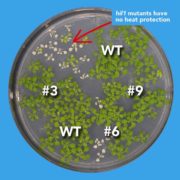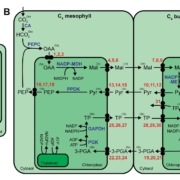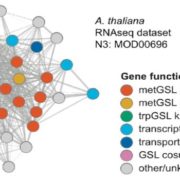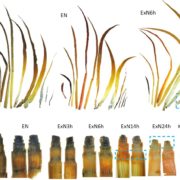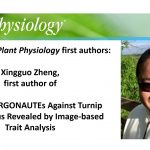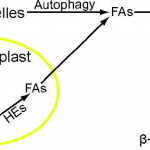Autophagy regulates lipid biosynthesis and turnover
Fan et al. explore the roles of autophagy in Arabidopsis lipid metabolism. Plant Cell https://doi.org/10.1105/tpc.19.00170
By Jilian Fan, Linhui Yu and Changcheng Xu
Biology Department, Brookhaven National Laboratory
Background: Autophagy is a self-eating process during which cytoplasmic materials including macromolecules and organelles are delivered to vacuoles (yeast and plants) or lysosomes (mammals) for degradation. This evolutionarily conserved catabolic mechanism is functional at basal levels in virtually all cell types under favorable growth conditions but can also be massively induced by stress. While basal autophagy is an essential quality control process that maintains cellular homeostasis by degrading obsolete or defective organelles, misfolded proteins and pathogens, the inducible autophagy functions primarily as an adaptive response to environmental stress, particularly starvation. Lipid droplets (LDs) are intracellular organelles that control the storage and metabolism of energy-rich neutral lipids, mainly triacylglycerol (TAG). Under starvation conditions, LDs are broken down to release lipids for energy production via autophagy-dependent and -independent mechanisms. The autophagy-mediated degradation of LDs, termed lipophagy, has been extensively studied in yeast and animals, but little information is available regarding the role of autophagy in lipid metabolism and storage in plants.
Question: We wanted to know whether autophagy is involved in the biogenesis and turnover of LDs. We were also interested in understanding the mechanistic basis of lipophagy in plants.
Findings: We found that basal autophagy contributes to LD biogenesis, whereas inducible autophagy contributes to LD degradation in Arabidopsis. Disruption of basal autophagy impedes organellar membrane turnover, and hence the supply of fatty acids liberated from membrane lipids for the synthesis of TAG. We demonstrated that lipophagy is induced under starvation as indicated by colocalization of LDs with the autophagic marker protein and the presence of LDs in vacuoles. We additionally showed that lipophagy occurs in a process morphologically resembling microautophagy and requires the core components of the autophagic machinery. This study provides mechanistic insight into lipophagy and reveals a dual role for autophagy in regulating lipid synthesis and turnover in plants.
Next steps: Further studies are needed to examine the exact mechanism underlying microlipophagy in plants, how TAG is hydrolyzed in vacuoles and the regulation and physiological functions of lipophagy.
Jilian Fan, Linhui Yu and Changcheng Xu. (2018). Dual Role for Autophagy in Lipid Metabolism in Arabidopsis. Plant Cell DOI: https://doi.org/10.1105/tpc.19.00170
Key words: autophagy, lipid droplet, lipid, metabolism



